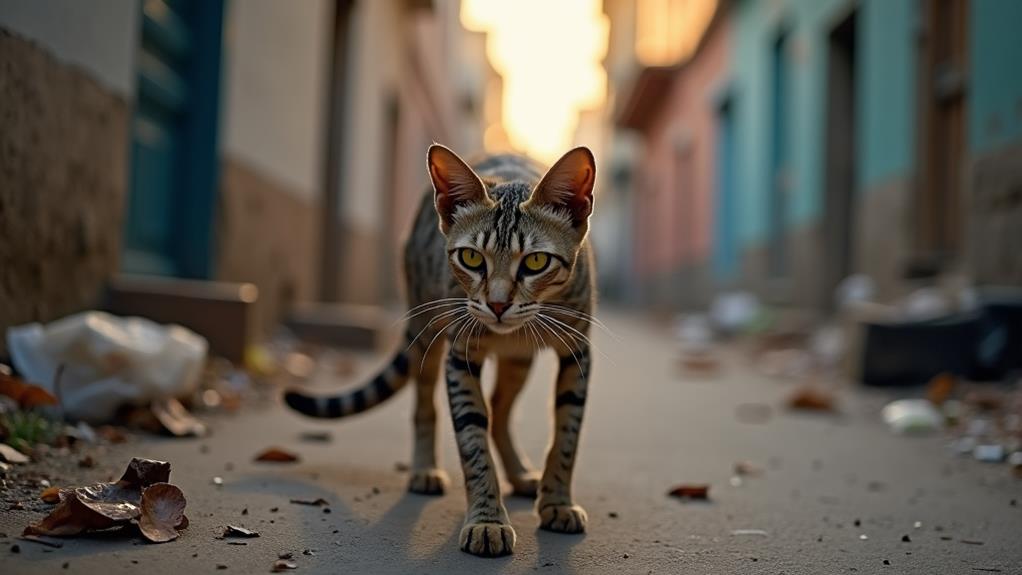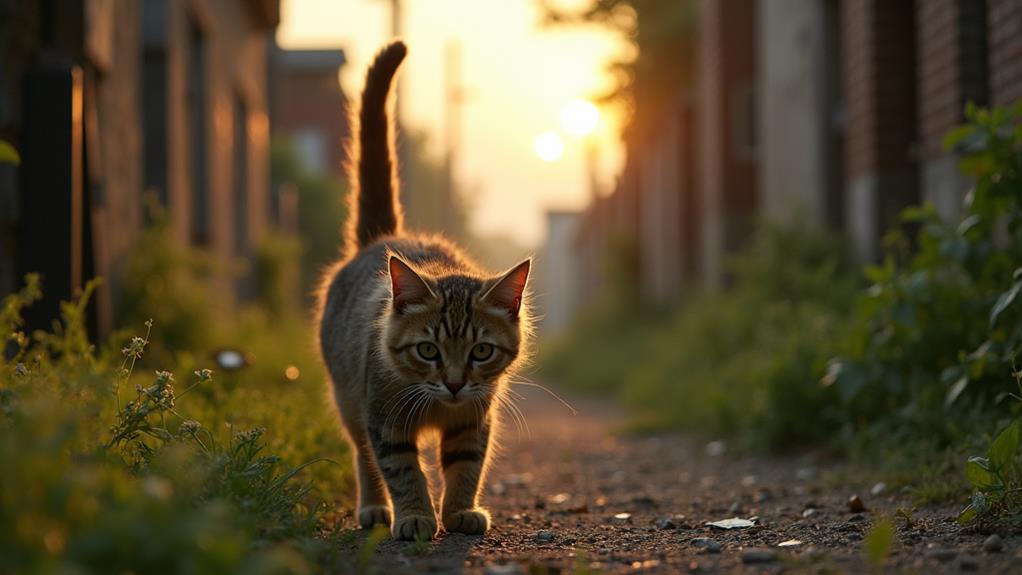How to Trap a Feral Cat Without a Trap: Humane Alternatives

Trapping a feral cat without a conventional trap involves creativity and patience. Start by understanding their behaviors—cats respond to familiar sounds and smells. Set up a consistent feeding routine using high-value foods to build trust. A large pet carrier can function as a trap if lined with comfortable bedding and irresistibly scented food. Creating a food trail can also lure the cat to a safe area. Use a towel to gently cover and calm the cat for capture. Protect yourself with gloves and guarantee the cat's safe transport. By exploring these alternatives, you'll uncover more effective trapping methods.
Understanding Feral Cat Behavior
Understanding feral cat behavior is vital if you're planning to humanely trap one. Feral cats are naturally wary of humans and will avoid unfamiliar situations. This makes them tricky to approach without the right strategy. They often live in colonies, relying on complex social structures to find food and shelter. By observing their behavior, like nocturnal hunting and territorial marking, you can identify patterns that will aid in your trapping efforts.
Recognizing these behaviors is essential. Feral cats are more likely to respond to food incentives, as hunger can override their cautious nature. Offering food in a consistent, quiet spot can help build a sense of familiarity, making them more comfortable. Moreover, familiar sounds, such as the rustling of a food bag, can serve as an auditory cue to draw them closer.
It's significant to differentiate between feral and stray cats. Feral cats are less socialized and often display aggression or fear when approached. This understanding allows you to tailor your approach, using food as a non-threatening incentive to gently coax them without resorting to traps. Observing and respecting their natural behavior will increase your chances of success.
Preparing a Safe Environment
To successfully trap a feral cat, it's crucial to initially create a safe and inviting environment for them. Start by choosing a quiet, sheltered area that minimizes disturbances. This helps the cat feel secure and more likely to approach. Keep in mind the significance of comfort; remove clutter and potential hiding spots to reduce escape routes, making it easier to approach the cat if needed.
Incorporate familiar items to make the environment more welcoming. Using familiar scents, like a blanket or toy the cat might recognize, can provide supplementary comfort, encouraging them to feel at ease. Verify the area is free from other animals, reducing stress and allowing the cat to investigate without competition.
Here's what you can do:
- Create a quiet, sheltered space: Reduces noise and disturbances.
- Remove clutter and hiding spots: Limits escape routes and makes the environment more open.
- Use familiar scents or items: Helps the cat feel more at home.
Regularly monitor the area to observe the cat's behavior and adjust the setup as needed, guaranteeing a continually safe and comfortable environment. By focusing on these steps, you'll set the stage for a successful and humane approach to trapping.
Building Trust With Feeding

Building trust with a feral cat often starts with a simple act: feeding. Begin by establishing a consistent feeding routine. Provide food at the same time and location every day. This consistency helps the cat associate you with reliability and care, gradually building trust over time. Use high-value, smelly food options like canned tuna or chicken to entice the cat. These appealing scents make the food more irresistible, encouraging the cat to return regularly for meals.
As the cat gets comfortable with the routine, gradually move the food closer to your desired location, such as near a carrier or a designated area. This acclimates the cat to the space without making it feel forced. Always observe the cat's behavior closely. Allow it to approach the food at its own pace, ensuring it feels safe and unthreatened during feeding sessions. This patience is vital for enhancing trust.
Consider setting up a feeding station or shelter where the cat can eat securely. This provides a sense of safety, reducing skittishness and encouraging regular visits. With time and patience, your consistent feeding routine can transform a wary feral cat into a trusting companion.
Using a Large Carrier
Once you've established a consistent feeding routine, you can consider using a large carrier as a humane way to capture the feral cat. Position the carrier in the cat's familiar feeding area where it feels safe. This setup encourages the cat to investigate the carrier at its own pace. To increase your chances of success, line the carrier with comfortable bedding and scents the cat recognizes.
Using enticing food, like tuna or canned mackerel, can make the carrier more appealing. Place a bit of this food inside the carrier to lure the cat in. If you're targeting a mother cat, placing her kittens inside the carrier can be a powerful draw, as she will instinctively want to be with them.
Here are some tips to guarantee a smooth capture:
- Create a food trail leading to the open carrier, enticing the cat to enter.
- Monitor the carrier closely to secure the cat safely and prevent stress.
- Use familiar scents and comfortable bedding to make the carrier inviting.
These humane alternatives respect the cat's freedom while providing a safe method to capture it when necessary.
Creating a Food Trail

Why not guide the feral cat gently with a well-placed food trail? Start by choosing enticing food items like tuna or chicken. These strong-smelling foods can attract the cat from a distance. Cats must rely on their keen sense of smell, so a potent scent will lead them naturally along the path you've set. Position small pieces strategically, spacing them out to guarantee the cat doesn't feel overwhelmed or suspicious.
As you set the food trail, it's essential to monitor the food regularly. This allows you to observe the cat's activity and adjust the trail if needed. Maybe the cat is hesitant at a certain spot, so try moving the food closer together to enhance its confidence. Every cat is different, so experimenting with diverse foods can help determine what this particular feline finds most irresistible.
Employing Distraction Techniques
Engage a feral cat's natural curiosity by employing distraction techniques that can guide them to a desired spot. Start by creating an irresistible food trail using strong-smelling foods like tuna or sardines. This will entice the cat to follow the scent, leading them to the designated area. As a humane alternative, these methods guarantee you can guide the cat without causing undue stress.
Consider using auditory cues. Recorded sounds of meowing or a crying kitten can effectively attract feral cats, drawing them closer. Their natural curiosity compels them to investigate these familiar sounds, making it easier for you to guide them.
Other distraction techniques include using a laser pointer to captivate their attention. Cats are naturally drawn to the movement of the laser, allowing you to direct them to a specific spot. Furthermore, hanging cooked chicken or another enticing food above an area can focus their attention on the food, rather than their surroundings.
- Use recorded sounds: Meowing or crying can attract feral cats.
- Hang enticing food: Draw attention with cooked chicken.
- Laser pointer play: Guide the cat with movement and curiosity.
These distraction techniques work effectively to gently and humanely lead a feral cat to a desired location.
Utilizing a Towel or Blanket

A towel or blanket can be a surprisingly effective tool for capturing a feral cat humanely. By using these simple household items, you can establish a grip on the cat while minimizing stress and fear. Begin by approaching the cat slowly and calmly, giving it time to get used to your presence. This gradual approach helps prevent startling the cat, making your capture attempt more likely to succeed.
When you're ready, aim to cover the cat's head with the towel or blanket initially. This technique reduces the cat's ability to see and escape, helping to calm it. Confirm your towel or blanket is large enough to completely envelop the cat, securing it from all sides. This full coverage not only prevents escape but also offers the cat a sense of security, reducing its anxiety.
Once the cat is wrapped securely, you'll need to transport it safely. Place the wrapped cat in a carrier or another secure space to guarantee its safety during relocation. This step is vital to prevent injury and verify the cat remains contained. With patience and care, a towel or blanket can become your key tool for a successful and humane capture.
Health and Safety Precautions
When handling feral cats, prioritizing health and safety precautions is critical for both you and the animal. To start, always wear gloves to protect yourself from bites and scratches, which can transmit diseases like toxoplasmosis and cat scratch fever. Keeping a safe distance is important; approach the cat slowly and calmly to minimize stress and avoid injuries to either party. Before handling, visually assess the cat's health for any visible injuries or signs of illness.
Here are some key precautions to keep in mind:
- Gloves: Confirm you're wearing thick, protective gloves to prevent direct contact with the cat's teeth and claws.
- Safe Distance: Approach cautiously; sudden movements can frighten the cat and lead to defensive actions.
- Hygiene: After handling the cat or any makeshift capture tools, wash your hands thoroughly to reduce the risk of zoonotic disease transmission.
If you're using items like towels or blankets to capture the cat, be gentle to avoid causing panic or injury. Remember, maintaining proper hygiene is crucial not only for your health but also to prevent spreading potential diseases. By following these guidelines, you can help guarantee a safe and humane experience for everyone involved.
Collaboration With the Community

Fostering collaboration with the community is fundamental in effectively managing feral cat populations. By engaging local community members in trapping efforts, you can increase awareness and enhance collaboration, leading to more successful management outcomes. Partnering with local shelters and animal welfare organizations provides valuable resources, support, and expertise needed for humane trapping initiatives. These partnerships can be instrumental in equipping you with the knowledge and tools required for effective feral cat management.
Organizing community events centered on education about feral cat populations and responsible pet ownership is another powerful strategy. These events can inspire more people to get involved, providing a platform to learn and engage. Education is key to fostering a caring community that understands the importance of managing feral cat populations humanely.
Creating a social media group or forum is an excellent way to connect individuals interested in feral cat trapping and care. Sharing experiences and strategies can lead to creative solutions and stronger community bonds. Moreover, collaborating with veterinarians to offer spaying and neutering services during community events can help reduce the feral cat population considerably. This holistic approach guarantees that the community is well-equipped and informed to address feral cat challenges effectively.
Exploring Legal Considerations
Having established a strong community foundation, it's vital to reflect on the legal aspects of feral cat trapping. Initially, familiarize yourself with local regulations, as laws can vary by jurisdiction. Some areas might require permits for trapping activities, so understanding these nuances is fundamental for effective feral cat management. Engaging with local authorities and animal control agencies can provide valuable guidance on best practices and guarantee compliance with relevant laws.
When considering trapping methods, prioritize humane treatment. Certain traps, like steel-jaw traps, may be prohibited due to their harmful nature. Confirming humane handling aligns with animal welfare legislation, which mandates humane care for trapped animals, including daily monitoring to prevent stress or suffering.
To maintain transparency and community trust, document all trapping efforts and interactions with local wildlife authorities. This documentation supports community engagement and highlights your commitment to ethical practices. Here's a checklist to keep in mind:
- Familiarize with local regulations: Check if permits are required for trapping activities.
- Guarantee humane treatment: Avoid prohibited traps and monitor animal welfare.
- Document everything: Keep records of trapping efforts and communications with authorities.




